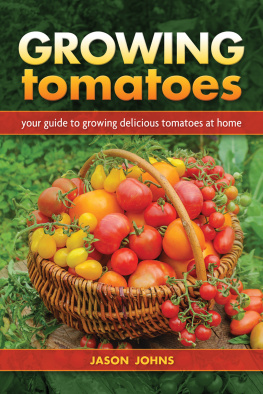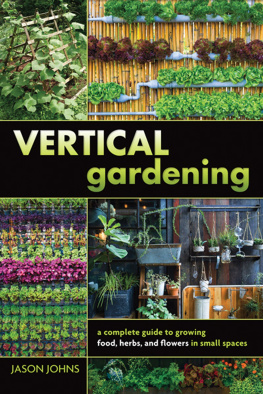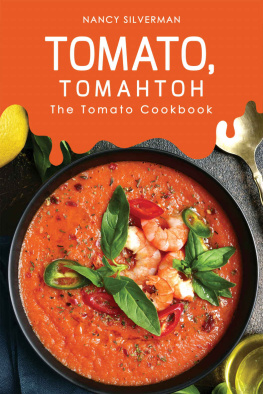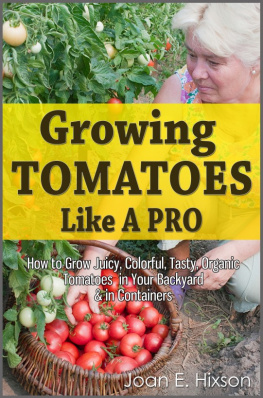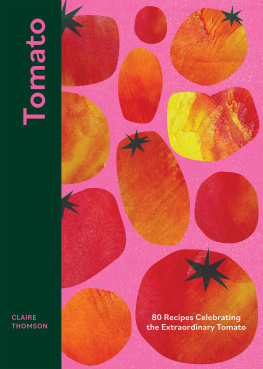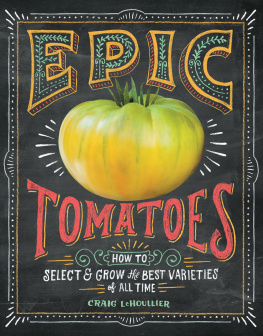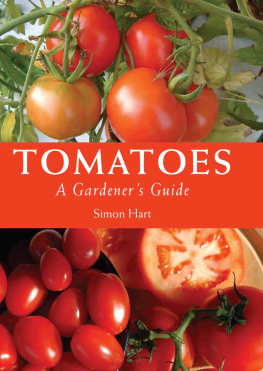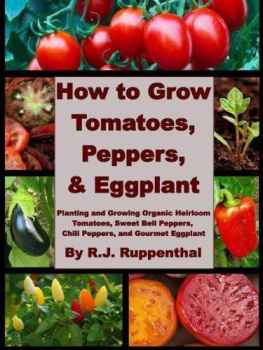

Library of Congress Cataloging-in-Publication Data
We chose to print this title on sustainably harvested paper stock certified by the Forest Stewardship Council, an independent auditor of responsible forestry practices. For more information, visit us.fsc.org. | |
2019 Jason Johns
All rights reserved. No portion of this book may be reproduced by any means whatsoever, except for brief quotations in reviews, without written permission from the publisher.
Cover and interior design: John Wincek
Stock photography: 123 RF
Printed in the United States of America
GroundSwell Books
an imprint of Book Publishing Company
PO Box 99
Summertown, TN 38483
888-260-8458
bookpubco.com
ISBN: 978-1-57067-366-5
23 22 21 20 19 18 1 2 3 4 5 6 7 8 9
CONTENTS
Introduction
T omatoes are one of the most popular fruits in the world. They are incredibly versatiledelicious both raw and cookedand they add rich flavor to the foods of many cultures.
Planted in late spring and harvested from midsummer to mid-autumn, tomatoes are an enjoyable and delicious food to grow in the home garden. Novice gardeners find tomatoes extremely appealing because theyre easy to plant, produce good results, and are relatively simple to care for. Besides being a favorite addition to a garden plot, tomatoes can also be grown in pots or hanging baskets, making them an ideal high-yield plant for people without a separate garden.
Commercial tomato farming is done all over the world. In the United States, tomatoes are cultivated extensively in southern states, where a long growing season extends the harvest. However, even vegetable farmers in the colder climates of Michigan and New Jersey grow significant crops of tomatoes at the height of summer.
The tomato is a member of the nightshade (or Solanaceae) family. Its known either by the Latin term thats been popular for the last two centuries, Lycopersicon esculentum, or the name many botanists now think is more correct, Solanum lycopersicum. Because of how tomatoes are used for culinary purposes, most people refer to them as vegetables, and thats how theyre marketed. However, botanists classify tomatoes as fruits because tomatoes are actually the berries of the tomato plant and come from just a single ovary within each tomato flower. (Similarly, peppers and cucumbers are also fruits that masquerade as vegetables.) The tomato was officially classified as a fruit in the US until the late 1800s to avoid taxation, but a Supreme Court ruling deemed the tomato a vegetable so the government could collect much needed taxes from growers.
Theres a tomato to suit every need or preference. If size is your concern, you can find a range from small, delicately flavored cherry or baby plum tomatoes to the giant beefsteak tomatoes that are popular either sliced for sandwiches or grilled or stuffed whole and baked. In general, tomatoes are considered to be somewhat sweet, but different varieties have distinctive flavors. Small tomatoes tend to be sweeter than large ones, which can have a slightly acidic or bitter taste. Cooking will temper those acidic flavors, bringing out the tomatos delicious sweetness. Certain varieties of tomatoes make juicy additions to salads, while tomatoes that have a thick flesh, such as Romas, are good candidates for sauces and salsa. Tomatoes also come in a wide range of colors, from red to yellow, orange, and greenand even black, white, purple, and striped! Growing tomatoes of different colors will give you the makings for some interesting dishes, and I always grow several varieties so I can impress houseguests with colored tomato salads.
Tomatoes have to be one of the most eagerly awaited fruits of the summer; being able to pick a ripe tomato and eat it straight from the vine is a wonderful experience that everyone should have. Although you can buy tomatoes from the supermarket throughout the year, the tomatoes youve grown at home or are freshly picked will have the best flavor. If youre buying produce in a market, choose tomatoes that are locally grown and wait until theyre in season. Tomatoes grown out of season or transported long distances tend to be more watery and less flavorful. Tomatoes that are sold still on the vine have had more time to ripen naturally and therefore have more flavor than tomatoes that have been picked and transported before theyre ripe.
The History of Tomato Cultivation
T omatoes are strongly associated with Italian cuisine, but they didnt originate in the Mediterranean region. The tomatos ancestral home is thought to have been thousands of miles away in western South America, in areas of Chile, Peru, Ecuador, Columbia, Bolivia, and even the Galapagos Islands!
Though popular in South America, the first cultivated tomatoes are believed to have been small cherry tomatoes grown by the Aztecs in Mexico. The origin of the word tomato is probably from the Aztec tomatl, which translates as the swelling fruit. Tomatoes were not introduced into Europe until seeds were returned to Spain in the sixteenth century by explorers who had visited the New World. The French gave it the name pomme damour, or love apple, because of the tomatos heart shape.
Tomatoes were viewed with suspicion when they were introduced in Europe and were deemed unfit to eat because theyre members of the nightshade family. Along with other members of this familyeggplants (aubergine), hot peppers, bell peppers, and potatoes, to name a fewtomatoes were thought to contain suspect, perhaps even dangerous, substances. While tomatoes do contain alkaloids (like one of their more toxic relatives, tobacco), these alkaloids are in such small quantities that virtually everyone can tolerate them.
In sixteenth-century Europe, this exotic new vegetable was primarily afforded by the wealthy. The upper classes often ate off plates made of pewter, which is a lead alloy, and foods that are high in acid (which tomatoes are) leech the lead out of pewter. As a result, consuming tomatoes on pewter plates would cause lead poisoning and, in many cases, death. Wealthy Europeans avoided eating tomatoes until they adopted the use of crockery in the 1800s, yet the poor, who made their plates from wood, enjoyed this culinary delight whenever they could obtain it.
Because the environment around the Mediterranean is very similar to the hot, dry climate of the tomatos home in South America, tomatoes grew easily in this region of Europe. So its not surprising that they were readily adopted into Italian cuisine. In fact, the growing popularity of tomato consumption in the US in the late 1800s was spurred by the wave of Italian immigrants who brought with them a cuisine rich with tomatoes. Perhaps more importantly, they brought pizza, on which tomato sauce was an essential ingredient. The modern pizza was invented in Naples, as legend has it, to celebrate a visit by Queen Margherita. A restaurant owner was supposed to have created the pizza from three ingredients that were representative of the colors of the new Italian flag. The tomato sauce provided the red, mozzarella cheese the white, and basil leaves scattered on the top represented the green.
Next page
